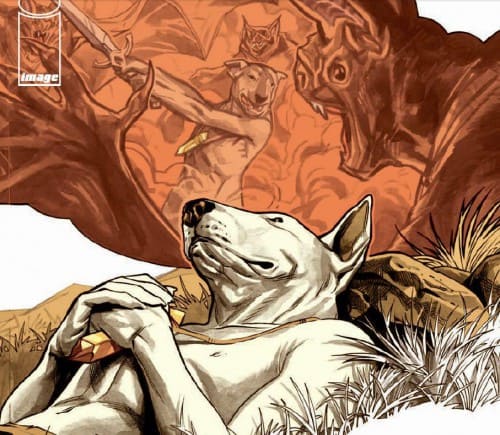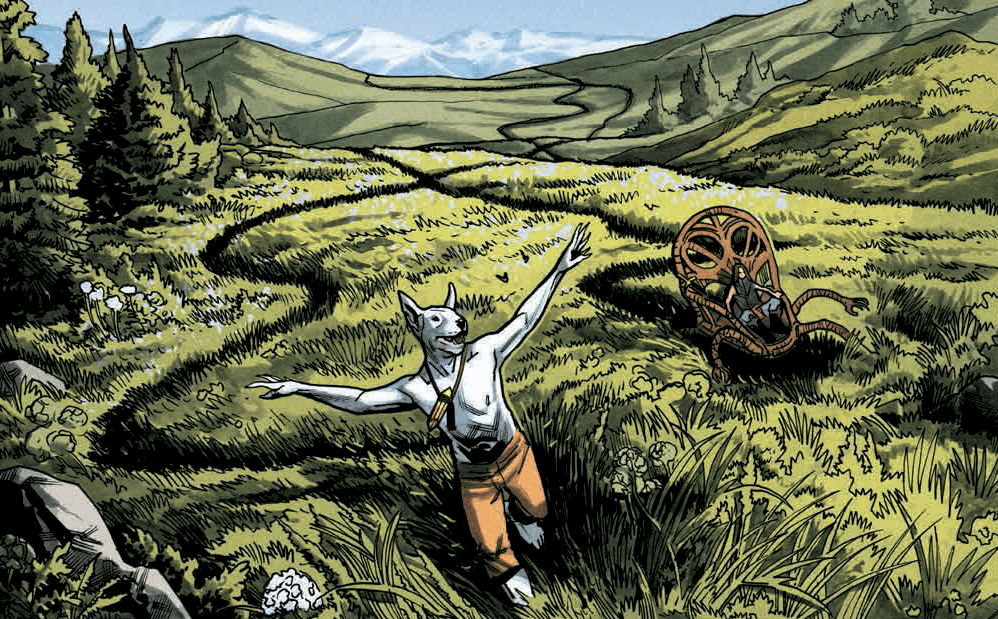
Written by Kurt Busiek
Art by Benjamin Dewey
Colors by Jordie Bellaire
Letters by COMICRAFT
Published by Image Comics
In a future Earth populated by animal humanoids, the magic they depend on is slowly disappearing. To save their world, the beastlings summon a champion from the past they did not expect, a technologically advanced super soldier. He is the only human being in their world and regarded with suspicion. Will he rise to be the hero of the Autumnlands or is he a new threat?
Combine the epic scale of Lord of the Rings, the dystopian scifi of Blade Runner, and populate it with a bunch of furries, and you get The Autumnlands.
Kurt Busiek has already mastered the superhero genre with his classics Marvels and Astro City. The acclaimed writer is now set to conquer scifi/fantasy. From the first issue on, Busiek creates a unique cast of characters. Dunstan, the young, enthusiastic terrier magician; Gharta, the warthog that will save magic no matter the cost; Sandorst, the greedy, ambitious owl politican; and Learoyd, the grim human champion. Each character is unique and has a distinct voice, making them strangely human despite their beastly appearance.
Although Busiek makes a distinction between hero and villain, those distinctions are blurry. Gharta wants to save magic, but her actions lead to the destruction of a city. Learoyd might protect the beastlings from danger, but he is a ruthless killer. The foxy trader Goodfoot might be ready to scam the citizens of Keniel, but only if they are unharmed. Even the central villains, the Lesser Ones, a race of buffalo people resembling Native Americans, are abused by the magical sky-dwellers and forced to live in poverty. Perhaps their violent attacks are justified. It is good to see that Busiek is taking an idea that could easily be cartoonish and treating it seriously. The only flat characters are the children and only because the first arc focuses on the conflict between the adult characters. There is plenty of room in future arcs to grow Dunsten and his friends.
In scifi/fantasy, there needs to be a unique world to populate unique characters. Kurt Busiek’s got it covered, as The Autumnlands is an expansive world with rich mythos. Each issue contains a short story written and illustrated by a guest writer and artist. It’s reminiscent of classic fantasy novels that would summarize important background information before throwing readers in the middle of the action. It is a nice technique that explains things without dragging down the story. One feels they are actually exploring the world and that it has a personality, not just a random place.
Bringing this world to life is Benjamin Dewey. His art is detailed and realistic, keeping the animal humanoids close to reality while expressing a wide range of movement and emotions. Clothing, weapons, and jewels make each character distinct and rarely do they seem like copies of each other. Dewey also takes care to make the settings equally detailed. Unfortunately, modern comic illustrators seem to completely ignore natural environments. It’s cool the big muscle guy has a third barrel on his shotgun, but it doesn’t matter if he’s in a bland corridor with only a discarded snicker bar as decoration. Aided by superb colorist Jordie Bellaire, Dewey fills The Autumnlands with sprawling grasslands, towering mountains, dark caves, rushing blue rivers, and metal cities floating in the sky. Dewey draws the panels like a movie camera to show the characters in the scenery. One feels immersed in this world and standing beside characters. The only let down is the last page, and the immersion is over. So sad.
One element of the story that might throw off readers is the mixture of science ficiton and fantasy. This is not a new approach and has been done by other comics. However, The Autumnlands does it uniquely by setting up the timeline where the scifi takes place in the past and the fantasy in the future. In the modern mindset, magic = past, technology = future, with a tendency to deem the latter as superior. By reversing the order, the comic subverts expectations and speculate which power source is really superior. Also, the dual presence of two genres contrasts Learoyd from the animal people. He has technological devices that make him superior, yet he makes decisions that even the most ruthless beastling finds abhorrent. The animal people, while capable of fantastic spells, are self-serving and their blunders lead to devastating consequences. This adds to the moral grayness of the series and sends a strong message about both genres. Philosophically, scifi tends to promise a better world by looking to the future and advancing technology; fantasy promises a better world by reviving the past and honoring tradition. Showing the flaws of both, The Autumnlands is a reminder to never expect either vision to be perfect.
The Autumnlands is on break right now, but will return. This gives any new reader the time to jump in. It is a stellar comic brought to life by a unique story and beautiful, detailed art. The series aims big and looks to sit along Saga, East to West, and Low in Image’s ever expanding library of genre epics.



